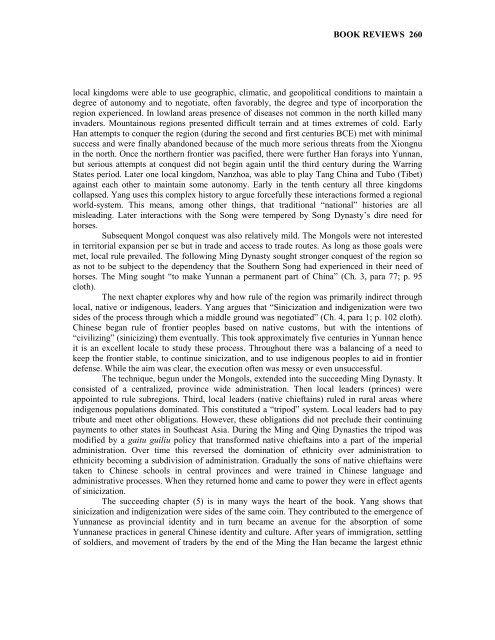Entire Volume 17 issue 1 - Journal of World-Systems Research ...
Entire Volume 17 issue 1 - Journal of World-Systems Research ...
Entire Volume 17 issue 1 - Journal of World-Systems Research ...
You also want an ePaper? Increase the reach of your titles
YUMPU automatically turns print PDFs into web optimized ePapers that Google loves.
BOOK REVIEWS 260<br />
local kingdoms were able to use geographic, climatic, and geopolitical conditions to maintain a<br />
degree <strong>of</strong> autonomy and to negotiate, <strong>of</strong>ten favorably, the degree and type <strong>of</strong> incorporation the<br />
region experienced. In lowland areas presence <strong>of</strong> diseases not common in the north killed many<br />
invaders. Mountainous regions presented difficult terrain and at times extremes <strong>of</strong> cold. Early<br />
Han attempts to conquer the region (during the second and first centuries BCE) met with minimal<br />
success and were finally abandoned because <strong>of</strong> the much more serious threats from the Xiongnu<br />
in the north. Once the northern frontier was pacified, there were further Han forays into Yunnan,<br />
but serious attempts at conquest did not begin again until the third century during the Warring<br />
States period. Later one local kingdom, Nanzhoa, was able to play Tang China and Tubo (Tibet)<br />
against each other to maintain some autonomy. Early in the tenth century all three kingdoms<br />
collapsed. Yang uses this complex history to argue forcefully these interactions formed a regional<br />
world-system. This means, among other things, that traditional “national” histories are all<br />
misleading. Later interactions with the Song were tempered by Song Dynasty’s dire need for<br />
horses.<br />
Subsequent Mongol conquest was also relatively mild. The Mongols were not interested<br />
in territorial expansion per se but in trade and access to trade routes. As long as those goals were<br />
met, local rule prevailed. The following Ming Dynasty sought stronger conquest <strong>of</strong> the region so<br />
as not to be subject to the dependency that the Southern Song had experienced in their need <strong>of</strong><br />
horses. The Ming sought “to make Yunnan a permanent part <strong>of</strong> China” (Ch. 3, para 77; p. 95<br />
cloth).<br />
The next chapter explores why and how rule <strong>of</strong> the region was primarily indirect through<br />
local, native or indigenous, leaders. Yang argues that “Sinicization and indigenization were two<br />
sides <strong>of</strong> the process through which a middle ground was negotiated” (Ch. 4, para 1; p. 102 cloth).<br />
Chinese began rule <strong>of</strong> frontier peoples based on native customs, but with the intentions <strong>of</strong><br />
“civilizing” (sinicizing) them eventually. This took approximately five centuries in Yunnan hence<br />
it is an excellent locale to study these process. Throughout there was a balancing <strong>of</strong> a need to<br />
keep the frontier stable, to continue sinicization, and to use indigenous peoples to aid in frontier<br />
defense. While the aim was clear, the execution <strong>of</strong>ten was messy or even unsuccessful.<br />
The technique, begun under the Mongols, extended into the succeeding Ming Dynasty. It<br />
consisted <strong>of</strong> a centralized, province wide administration. Then local leaders (princes) were<br />
appointed to rule subregions. Third, local leaders (native chieftains) ruled in rural areas where<br />
indigenous populations dominated. This constituted a “tripod” system. Local leaders had to pay<br />
tribute and meet other obligations. However, these obligations did not preclude their continuing<br />
payments to other states in Southeast Asia. During the Ming and Qing Dynasties the tripod was<br />
modified by a gaitu guiliu policy that transformed native chieftains into a part <strong>of</strong> the imperial<br />
administration. Over time this reversed the domination <strong>of</strong> ethnicity over administration to<br />
ethnicity becoming a subdivision <strong>of</strong> administration. Gradually the sons <strong>of</strong> native chieftains were<br />
taken to Chinese schools in central provinces and were trained in Chinese language and<br />
administrative processes. When they returned home and came to power they were in effect agents<br />
<strong>of</strong> sinicization.<br />
The succeeding chapter (5) is in many ways the heart <strong>of</strong> the book. Yang shows that<br />
sinicization and indigenization were sides <strong>of</strong> the same coin. They contributed to the emergence <strong>of</strong><br />
Yunnanese as provincial identity and in turn became an avenue for the absorption <strong>of</strong> some<br />
Yunnanese practices in general Chinese identity and culture. After years <strong>of</strong> immigration, settling<br />
<strong>of</strong> soldiers, and movement <strong>of</strong> traders by the end <strong>of</strong> the Ming the Han became the largest ethnic





